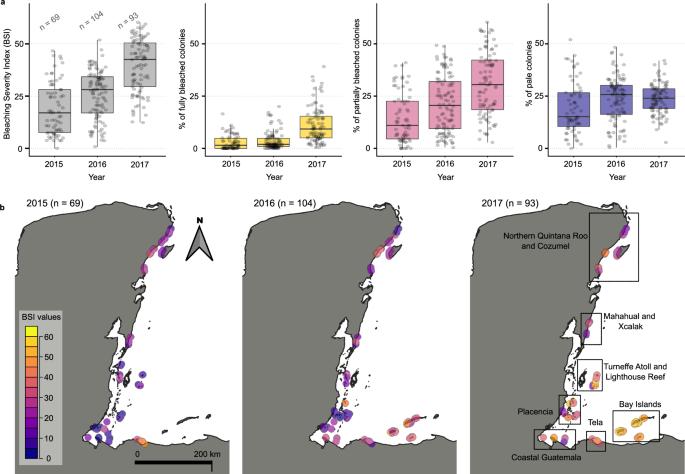中美洲珊瑚礁易受白化影响的根本原因。
IF 5.2
1区 生物学
Q1 BIOLOGY
引用次数: 0
摘要
珊瑚白化是珊瑚与藻类之间共生关系紧张的结果,由于气候变化导致热应力事件加剧,珊瑚白化现象也随之升级。尽管全球都在努力,但目前的预警系统缺乏本地精确性。我们的研究横跨 2015-2017 年的中美洲珊瑚礁,揭示了普遍的中期白化现象,并在 2017 年达到顶峰。通过仔细研究 23 个压力暴露和敏感性指标,我们准确预测了 75% 的白化严重程度变化。值得注意的是,与传统指数(如度升温周)相比,独特的热模式--特别是气候学季节升温率和各种热应力指标--成为更好的预测指标。令人惊讶的是,珊瑚群落多样化的深珊瑚礁显示出更高的脆弱性。本研究利用可获取的数据(包括历史和实时海面温度、生境变量和物种组成),提出了珊瑚礁白化脆弱性评估框架。其操作潜力在于与现有监测系统的无缝整合,为保护和管理提供重要见解。本文章由计算机程序翻译,如有差异,请以英文原文为准。

Underlying drivers of coral reef vulnerability to bleaching in the Mesoamerican Reef
Coral bleaching, a consequence of stressed symbiotic relationships between corals and algae, has escalated due to intensified heat stress events driven by climate change. Despite global efforts, current early warning systems lack local precision. Our study, spanning 2015–2017 in the Mesoamerican Reef, revealed prevalent intermediate bleaching, peaking in 2017. By scrutinizing 23 stress exposure and sensitivity metrics, we accurately predicted 75% of bleaching severity variation. Notably, distinct thermal patterns—particularly the climatological seasonal warming rate and various heat stress metrics—emerged as better predictors compared to conventional indices (such as Degree Heating Weeks). Surprisingly, deeper reefs with diverse coral communities showed heightened vulnerability. This study presents a framework for coral reef bleaching vulnerability assessment, leveraging accessible data (including historical and real-time sea surface temperature, habitat variables, and species composition). Its operational potential lies in seamless integration with existing monitoring systems, offering crucial insights for conservation and management. A study on the Mesoamerican Reef shows that the climatological rate of seasonal warming and heat stress metrics more accurately predict coral bleaching severity than conventional indices, enhancing regional early warning systems for better conservation strategies.
求助全文
通过发布文献求助,成功后即可免费获取论文全文。
去求助
来源期刊

Communications Biology
Medicine-Medicine (miscellaneous)
CiteScore
8.60
自引率
1.70%
发文量
1233
审稿时长
13 weeks
期刊介绍:
Communications Biology is an open access journal from Nature Research publishing high-quality research, reviews and commentary in all areas of the biological sciences. Research papers published by the journal represent significant advances bringing new biological insight to a specialized area of research.
 求助内容:
求助内容: 应助结果提醒方式:
应助结果提醒方式:


